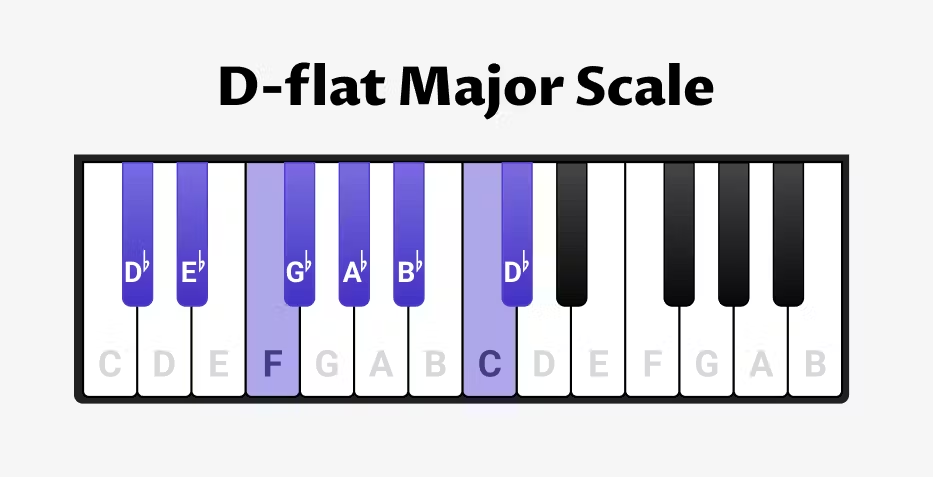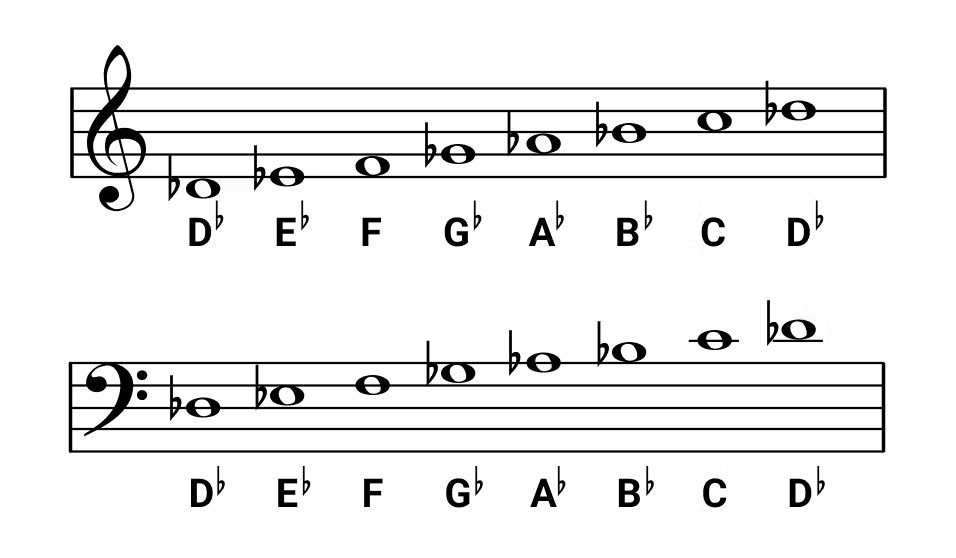The D-flat Major Scale for Piano - Notes, Chords & Exercises
Jump to section
You get a fascinating chord poster + exclusive content!

What Are the Pitches and Notes of the D-flat Major Scale?
The D-flat Major scale starts on D-flat and includes five flats. It uses the notes Db-Eb-F-Gb-Ab-Bb-C-Db. On the piano, you need to play five black keys and two white keys.

How to Play the D-flat Major Scale With the Right Hand (Treble Clef)
On the piano, you can play the D-flat Major Scale going up (toward the higher notes), or coming down. This scale is played most conveniently with a bit of thumb-tucking:
- Play the following notes going up in the treble clef: Db-Eb-F-Gb-Ab-Bb-C-Db. Start playing with your second finger on the Db, and after you have played the Eb with your third finger, tuck your thumb to reach the F. Continue up with the second, third, and fourth finger on Gb, Ab, and Bb, respectively, then tuck the thumb again to comfortably reach the C, and play the final Db with your second finger.
- Play the following notes going down: Db-C-Bb-Ab-Gb-F-Eb-Db. Go down inversing the exact way you have played coming up: Start playing with your second finger. After the thumb has played the C, tuck your fourth finger over to play the Bb, and continue until your first finger reaches the F. Then tuck your third finger over to play the Eb, and finish with the second finger on Db.

How to Play the D-flat Major scale with the left hand (bass clef)
Piano beginners may find it difficult to read and play the left hand. It is worth investing some time to really familiarize yourself with the notes of the D-flat Major scale in the bass clef, and learn how to read them in music scores.
The notes are the same in both clefs, treble, and bass, Db-Eb-F-Gb-Ab-Bb-C-Db, but they look different:

The way you play the scale and the fingering is similar to how you play the right hand.
- Going up: Start with the third finger on Db, then use the second finger to play the Eb, and the first finger to reach the F. Tuck your fourth finger over to reach the Gb, then play Ab and Bb with the third and second finger, and the C with the first. Tuck your second finger to reach the final Db with the second finger.
- Coming down: Simply reverse what you've just done - start out on Db with your second finger, play the C with your first, then Bb to Gb with your second, third, and fourth finger, tuck your thumb under to play the F. Continue down with the second and third finger on Eb and the final Db.
The D-flat Major Key Signature
The key signature, located at the beginning of each line of a piece, lets you see which notes will be raised (#) or flattened (b) consistently throughout that piece.
If you spot this key signature below it is very likely that the piece is in D-flat-Major (or it might be in B-flat-minor, the related minor key. You can determine that by listening to the major/minor "mood" of the piece):

6 Exercises to Practice the D-flat Major Scale
Play one exercise after the other and only move on after having correctly played the previous exercise 5 times on your piano:
- Play the left hand up and down using a metronome and slowly increasing speed
- Play the right hand up and down using a metronome and slowly increasing speed
- Play both hands up and down using a metronome and slowly increasing speed - this one is NOT easy, so take your time!
- Play the left hand up starting from the lowest Db to the highest, and down starting from the highest Db to the lowest
- Play the right hand up starting from the lowest Db to the highest, and down starting from the highest Db to the lowest
- Play both hands up starting with the left hand on the lowest Db and stopping when the right hand reaches the highest Db, then play down to the starting position
Why you should exercise scales in general:
- To memorize a scale
- To practice dexterity and intonation (play all keys with even loudness. Beginners often play the notes they work with their stronger fingers much harder. Aim for an even tone)
- To be able to play the scale in time without hesitating to find your fingerings
- To be able to build chords and improvise
D-flat Major Chords on the Piano
A chord is constructed of three or more notes: The root note - the major third - the perfect fifth.
Briefly explained this tells us for D-flat Major:
- The basic D-flat Major chord consists of Db-F-Ab.
- The first inversion is F-Ab-Db.
- The second inversion is Ab-Db-F.
To practice the D-flat Major chord and inversions, switch from the chord starting with the root note to the first, and the second inversion, starting slowly using a metronome, then increasing your tempo.
Top 10 pieces in D-flat-Major
- 1 Someone You Loved: Lewis Capaldi
- 2 (Everything I Do) I Do It For You: Bryan Adams
- 3 Jerusalema: Nomcebo Zikode, Master KG
- 4 Clair De Lune: Claude Debussy
- 5 Nothing's Gonna Change My Love For You: George Benson
- 6 I Just Called To Say I Love You: Stevie Wonder
- 7 May Be: Yiruma
- 8 Dancing On My Own: Calum Scott
- 9 I Got Rhythm: George Gershwin
- 10 Valse, Op. 64 No. 1 (Minute Waltz): Frédéric Chopin


